Samsung NP950QCG-X01DE operation manual

User Manual
www.samsung.com
Table of contents
Getting started
3 About this manual
7 Layout
14Turning the computer on and off
16 Unlocking the screen
16 Windows
Basics
18Using the computer as a tablet
20 Using the S Pen
32 Touch screen (optional)
37 Keyboard
39 Touchpad
42 Fingerprint recognition
44 Memory card tray
47 External display
49 Wireless LAN
51 Bluetooth
53Thunderbolt™ 3
54Wireless PowerShare (WPS)
Applications
57Using applications
58Samsung Settings
59Samsung Security
61Samsung Update
62Online Support (S Service)
63Samsung PC Help (Selfhelp application)
64Samsung PC Cleaner
65Quick Search
Settings & Upgrade
66 LCD brightness
68Volume
69BIOS (Setup utility)
75Battery
Troubleshooting
78 Samsung Recovery
83Windows recovery function
83 Q&A
Appendix
86Product specifications
87Ergonomic tips
91 Safety precautions
101Important safety information
104Replacement parts and accessories
107Regulatory compliance statements
116 WEEE symbol information
118Samsung package TakeBack program (USA only)
2
Getting started
About this manual
•This user manual is specially designed to detail the computer’s functions and features.
•The user manual supplied with the computer may vary depending on the model.
•Please read this manual before using the computer to ensure safe and proper use.
•Optional accessories, some devices, and software referred to in this manual may not be provided or may not be subject to upgrades. Note that the computer environment referred to in the user manual may not be the same as your environment.
•Descriptions are based on the computer’s default settings and the Windows 10 operating system. Available features and additional services may vary depending on the computer or operating system.
•This user manual describes procedures for using the touchpad, mouse and touch screen. Instructions for using the touch screen are for models with the touch screen feature.
•Images and screenshots are those of the representative model of the series and may differ in appearance from the actual product.
•Content may differ from the final product and is subject to change without prior notice. For the latest version of the manual, refer to the Samsung website, www.samsung.com.
3

Getting started
Instructional icons and expressions
Warning: situations that could cause injury to yourself or others
Caution: situations that could cause damage to the computer or other equipment
Note: notes, usage tips, or additional information
The path you should follow to carry out an instruction. For example,“select Settings →Devices”indicates that you should select Settings and then Devices.
Select Click the mouse or tap the touchpad or touch screen.
Copyright
Copyright © 2020 Samsung Electronics
This manual is protected under international copyright laws.
No part of this manual may be reproduced, distributed, translated, or transmitted in any form or by any means, electronic or mechanical, including photocopying, recording, or storing in any information storage and retrieval system.
Computer specifications or the contents of this manual may be changed without prior notice due to an upgrade of the computer’s functions.
4
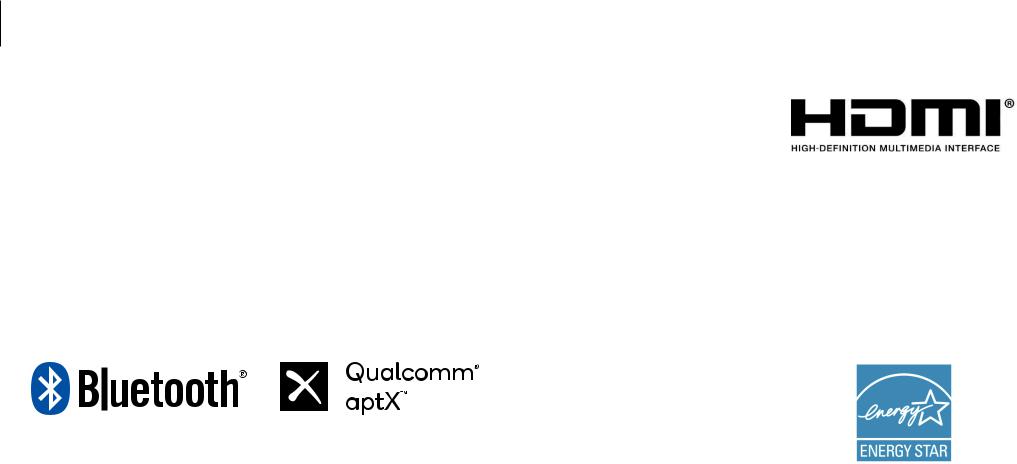
Getting started
Trademarks
•Samsung and the Samsung logo are trademarks or registered trademarks of Samsung Electronics.
•Intel and Core are trademarks or registered trademarks of the Intel Corporation.
•Microsoft, MS-DOS, and Windows are trademarks or registered trademarks of the Microsoft Corporation.
•Bluetooth® is a registered trademark of Bluetooth SIG, Inc. worldwide.
•Wi-Fi®, Wi-Fi Direct™, Wi-Fi CERTIFIED™, and the Wi-Fi logo are registered trademarks of the Wi-Fi Alliance.
•HDMI, the HDMI logo, and the term High Definition Multimedia Interface are trademarks or registered trademarks of HDMI Licensing LLC.
•Thunderbolt and the Thunderbolt logo are trademarks of Intel Corporation in the U.S. and/or other countries.
•All other trademarks and copyrights are the property of their respective owners.
As an ENERGY STAR® Partner, Samsung has determined that this product meets the ENERGY STAR® guidelines for energy efficiency.
•The ENERGY STAR Program has reduced greenhouse gas emissions and saved energy through voluntary labeling.
•Power management setting of this product has been enabled by default, and has various timing settings from 1 minute to 5 hours.
•The product can wake with a button press on the chassis from sleep mode.
5

Getting started
Data precautions
Samsung Electronics shall not be liable for any data loss. Please take care to avoid losing any important data and back up your data to prevent any such data loss.
Operating system and software support
If you change the product’s factory OS (Operating System) to another OS or if you install software which is not supported by the product’s original factory OS, you will not receive any technical support, product exchange or refund, and a fee will be charged when requesting a service.
Please use your computer with the original factory OS. If you install an OS other than the factory OS, data may be deleted or the computer may not start.
* Please use Windows 10 64-bit only for this model.
Product capacity representation
Storage capacity representation
The capacity of the storage device (HDD, SSD) of the manufacturer is calculated assuming that 1 KB = 1,000 Bytes.
However, the operating system (Windows) calculates the storage device capacity assuming that 1 KB = 1,024 Bytes. Therefore, the available capacity of the HDD in Windows is smaller than the actual capacity due to the difference in capacity calculation. For example, for an 80 GB HDD, Windows calculates the capacity as 74.5 GB, (80x1,000x1,000x1,000) Bytes/(1,024x1,024x1,024) Bytes = 74.505 GB.
In addition, the capacity representation in Windows may be even smaller because some programs, such as Samsung Recovery, may reside in a hidden area of the HDD.
Memory capacity representation
The available memory capacity in Windows is less than the actual capacity of memory. This is because some memory is required for regular system operations.
For example, for 1 GB (= 1,024 MB) memory installed, Windows may report the capacity as 1,022 MB or less.
6

Getting started
Layout
•Features or options may differ depending on the model.
•The items marked as optional may not be provided or may be provided in different locations.
•Since some space on the SSD is reserved for system recovery and operations, the available space on the SSD may be less than the actual capacity.
7
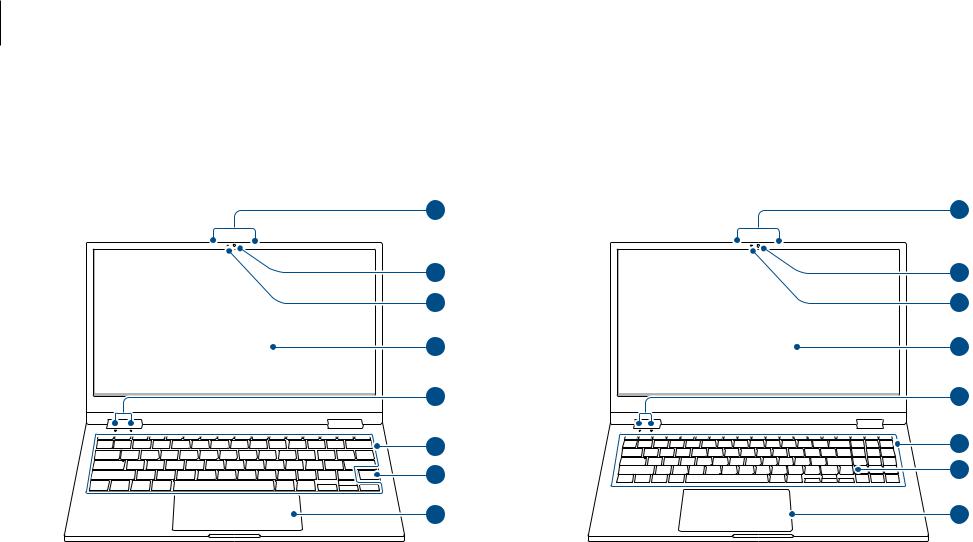
Getting started
Front view
►For 13.3 inch models |
►For 15.6 inch models |
1 |
1 |
2 |
2 |
3 |
3 |
4 |
4 |
5 |
5 |
6 |
6 |
7 |
7 |
|
|
8 |
8 |
8

Getting started
Number/Name |
Description |
|
Microphone |
• |
You can use the built-in |
|
microphone. |
|
|
|
|
|
|
|
Camera |
• |
Using this camera, you can take |
|
still pictures and record video. |
|
|
|
|
|
|
|
Camera indicator |
• |
This indicates the camera |
light |
|
operating status. |
|
|
|
|
• |
The screen’s images are displayed |
LCD/Touch screen |
|
here. |
(optional) |
• |
Recognizes touch interactions |
|
|
(Only for touch screen models). |
|
|
|
Operating |
|
|
status LED and |
• |
Shows the operating status of the |
Illumination |
|
computer. |
sensor |
|
|
Keyboard |
• |
Enter text or control computer |
|
functions. |
|
|
|
|
|
|
|
Number/Name |
Description |
|
Fingerprint |
• |
The fingerprint recognition sensor |
|
recognizes fingerprints. Scans a |
|
recognition |
|
|
|
fingerprint to sign in to Windows, |
|
sensor |
|
|
|
apps, and services. |
|
|
|
|
|
• |
Moves the cursor and selects |
Touchpad |
|
options. |
|
• |
Functions as a mouse. |
9

Getting started
Operating status LED and Illumination |
Number/Name |
sensor |
|
|
Operating status |
|
LED |
Illumination sensor
Description
•Shows the operating status of the computer.
––Red: Charging
––Green: Fully charged
––Blue: Turned on
•The sensor detects the ambient light.
•If the ambient light level becomes too low, the computer’s backlight will automatically turn on.
•If there is sufficient ambient lighting, the computer’s backlight will automatically turn off.
Do not block the sensor.
10
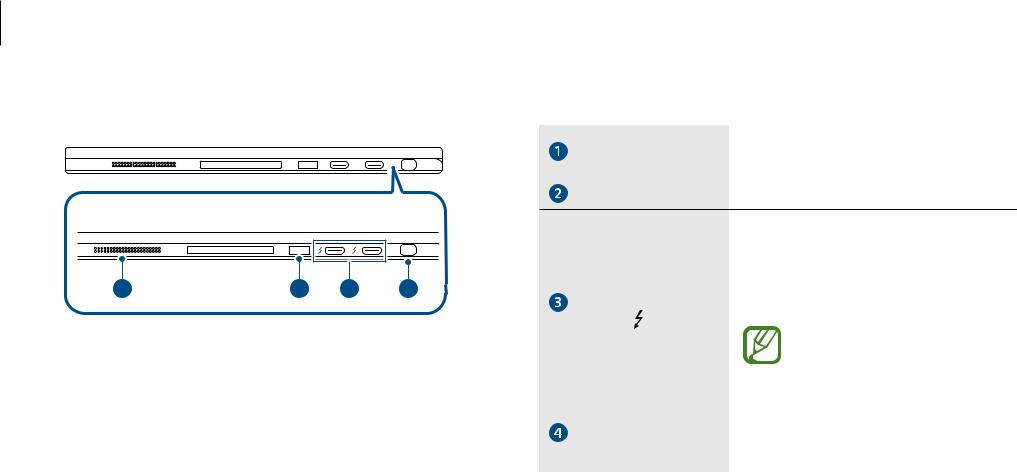
Getting started
Right view
1
2 |
3 |
4 |
Number/Name |
Description |
|
Speaker |
• |
Sound is emitted from the |
|
speakers. |
|
|
|
|
|
|
|
Power button |
• |
Turns the computer on and off. |
•Connect and charge a USB-C®
™3 device, orand Thunderbolt
Thunderbolt™ |
connect to an external display |
device. |
|
3 port |
Some features may not be |
|
|
|
supported depending on |
|
your device’s specifications. |
• |
Operate the computer by |
S Pen |
performing touch actions on the |
|
screen. |
|
|
11

Getting started
Left view
1 |
2 |
3 |
4 |
Number/Name |
Description |
|
Earpiece/Headset |
• |
Connect an earpiece or a headset |
|
to the computer to listen to |
|
jack |
|
|
|
audio. |
|
|
|
|
|
|
|
|
• |
This port allows the USB PD AC |
|
|
adapter to be used to supply |
USB-C® port |
|
power to the computer. It can |
|
also be used to charge USB-C® |
|
|
|
devices or to connect external |
|
|
display devices. |
|
|
|
Memory card tray |
• |
Insert a memory card. |
|
|
|
Speaker |
• |
Sound is emitted from the |
|
speakers. |
|
|
|
|
The charging feature of the USB-C® port or Thunderbolt™ 3 port
Charging the computer
Connect an external power supply (sold separately) to the USB-C® port or Thunderbolt™ 3 port to use it as the auxiliary power or charge the computer.
Use an external power supply (sold separately) with a rating level higher than 10 W (5 V, 2 A) that supports USB-C® or USB BC 1.2.
Charging a USB-C® device or Thunderbolt™ 3 device
Connect and charge your USB-C® or Thunderbolt™ 3 device by connecting it to the computer.
•It may take longer to charge the battery when charging a connected device.
•The battery power level may be reduced when charging a connected device while the computer is powered by the battery.
•The charging status of the connected device is not displayed on the computer.
•This charging feature may not be available on some devices.
12

Getting started
Bottom view
|
|
|
|
|
Number/Name |
Description |
|
|
|
|
|
|
|
• |
Sucks in outside air and discharges |
|
|
|
|
1 |
|
|
heat generated inside the computer |
|
|
|
|
|
|
||
|
|
|
|
Fan vents |
• |
through these holes. |
|
|
|||||||
|
|
|
|
|
If the vents are blocked the computer |
||
|
|
|
|
|
|
||
|
|
|
|
|
|
|
may overheat. Avoid blocking the vents |
|
|
|
|
|
|
|
as this may be dangerous. |
|
|
|
|
|
|
|
|
|
|
|
|
|
|
• |
Provides power to the computer when |
|
|
|
|
2 |
Internal |
• |
not connected to an AC adapter. |
|
|
|
|
||||
|
|
|
|
|
To remove or replace the internal |
||
|
|
|
|
|
battery |
|
battery, take it to a Samsung Service |
Center. You will be charged for this service.
If the case on the bottom of the device is replaced, the laser-carved model name, serial number, and various logos will not be displayed anymore.
For more information, contact a Samsung Service Center.
13
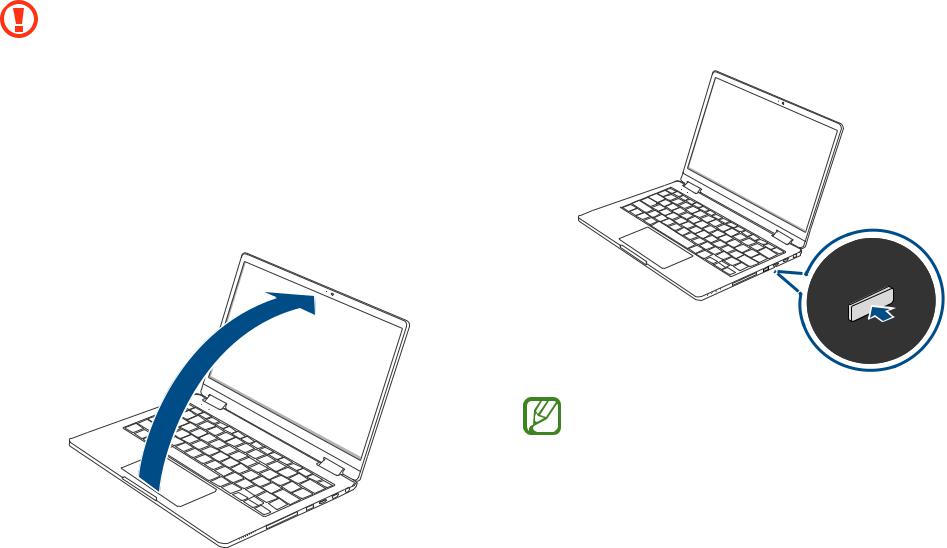
Getting started
Turning the computer on and off
Fully charge the battery using the AC adapter before using the computer for the first time.
3 The computer turns on automatically when the LCD panel is opened.
If the computer does not turn on automatically, press the Power button.
Turning the computer on
1 |
Before turning on the computer, check that the battery is |
|
charged and charge it if necessary. |
2 |
Open the LCD panel. |
Set the device to not turn on the computer automatically when the LCD panel is opened.
1. Select the Start button ( ) →Samsung Settings. 2. Select System →Auto booting →Off.
) →Samsung Settings. 2. Select System →Auto booting →Off.
14

Getting started
About Windows Activation
When you turn the computer on for the first time, the Windows activation screen appears.
Follow the activation procedures according to the instructions on the screen to use the computer.
The computer’s date and time may be incorrect when you turn it on for the first time. They may also be incorrect if the battery has been fully discharged or removed. To set the date and time, go to the desktop taskbar and right-click the date and clock area. Then, select Adjust date/time and set the current date and time.
Turning the computer off
1 |
Select the Start button ( ). |
||||
2 |
Select →Shut down. |
||||
|
|
|
|
|
|
|
|
|
|
|
|
|
|
|
|
|
|
|
|
|
|
|
|
|
|
|
|
|
|
|
|
|
|
|
|
Save all data before turning off the computer.
15

Getting started
Unlocking the screen
To unlock the lock screen, do one of the following:
•Touch screen: Swipe upwards from the bottom of the screen.
•Mouse: Click the lock screen.
•Keyboard: Press any key.
•Touchpad: Tap the touchpad.
If the account has a password, enter the password to log in after unlocking the screen.
Windows
Microsoft Windows is an operating system that is used to control a computer.
•Images and available features may differ depending on the model and operating system.
•This manual is designed for Windows 10 and content may differ depending on the OS version.
•The image displayed on the desktop screen may differ between models and OS versions.
16
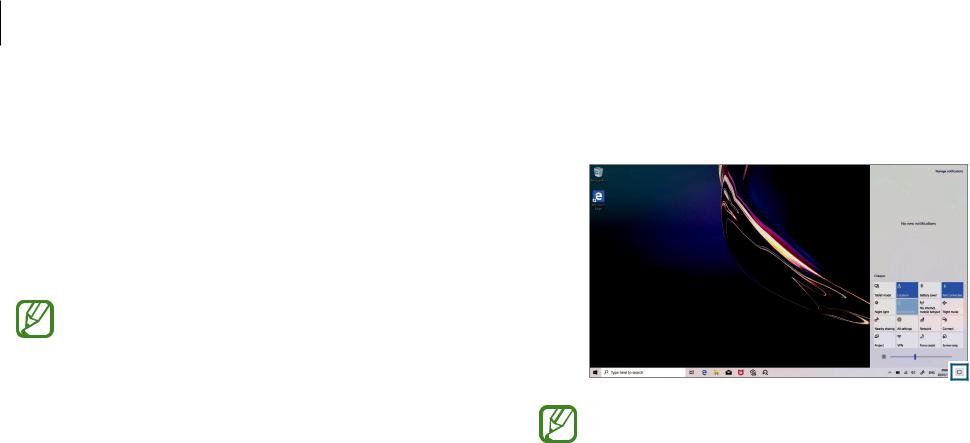
Getting started
Configuring the Windows Settings
You can configure the basic system settings, such as installing or uninstalling apps and managing accounts, on the Windows Settings screen.
Select the Start button ( ) →
) → .
.
Then, select an option you want to change after the Windows Settings screen appears.
You can also configure the settings from the Control Panel like previous OS versions. Select the Start button ( ) →
) →
Windows System →Control Panel.
Action Center
The Windows 10 action center allows you to receive system notifications, such as updates, and push notifications, such as emails and SNS updates. You can also adjust settings conveniently. For example, you can select wireless network options or adjust the volume and screen brightness via hot keys in the action center.
Checking notifications
1 Select  on the taskbar.
on the taskbar.
2 When the action center panel appears, select a message to check it.
•You can enable or disable push notifications for applications. You can also set personalized quick
actions to appear in the action center by selecting the Start button ( ) →
) → →System →Notifications & actions.
→System →Notifications & actions.
•Select Expand or Collapse to expand or minimize the action center menu and select the feature you want to use.
17

Basics
Using the computer as a tablet
You can use the computer as a tablet by folding the LCD panel behind the keyboard.
1 Open the LCD panel and rotate it away from the keyboard until it touches the bottom side of the computer.
When the LCD panel is tilted past the transition point
•The keyboard and touchpad will automatically be locked and will not function. But, during processes that start before Windows operation, such as the BIOS setup or DOS, the keyboard and touchpad will not be locked.
•The display will rotate automatically depending on the computer’s orientation.
When storing the computer in a bag or carrying it, close the LCD panel to protect the computer.
18
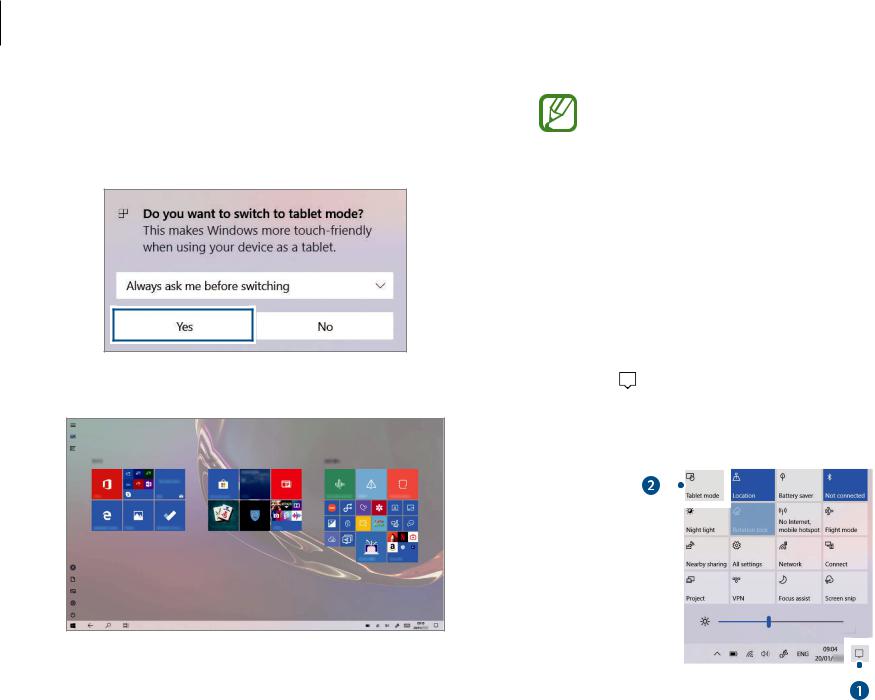
Basics
2 A mode switch confirmation message will appear when the
LCD panel is tilted past the transition point. Select Yes to switch the computer’s display to tablet mode.
The display will switch to tablet mode.
•When you rotate the LCD panel back to the normal position, a mode switch confirmation message will appear. Select Yes to switch the computer’s display to desktop mode.
•When the screen is turned off while using the computer as a tablet, touch the screen to unlock it. When the computer is in sleep mode, press the Power button to unlock the screen.
You can also switch the computer’s display to tablet mode without rotating the LCD panel.
1 |
Select on the taskbar. |
||||||
2 |
When the action center panel appears, select Tablet mode. |
||||||
|
|
|
|
|
|
|
|
|
|
|
|
|
|
|
|
|
|
|
|
|
|
|
|
|
|
|
|
|
|
|
|
|
|
|
|
|
|
|
|
|
|
|
|
|
|
|
|
19

Basics
Using the S Pen
S Pen
S Pen button
S Pen nib

Name Functions
• |
Use the S Pen to write, draw, or perform |
|
touch actions on the screen. |
S Pen nib |
Hover the S Pen over items on the |
|
screen to access additional S Pen |
|
features, such as the Air view feature. |
|
|
• |
Hover the S Pen over the screen and |
S Pen button |
press the S Pen button to display the |
|
Air command features. |
The FCC ID of the S Pen can be found below (USA only). FCC ID: A3LEJPN970
20

Basics
Taking out the S Pen
Press the end of the S Pen until it clicks to disengage it. Then, pull the S Pen from the slot.
To store the S Pen, reinsert it into the slot and push slightly until it clicks into place.
1
2
Replacing the S Pen nib
If the nib is dull, replace it with a new one.
New S pen nibs and tweezers are sold separately.
1 Firmly hold the nib with the tweezers and remove it.
21
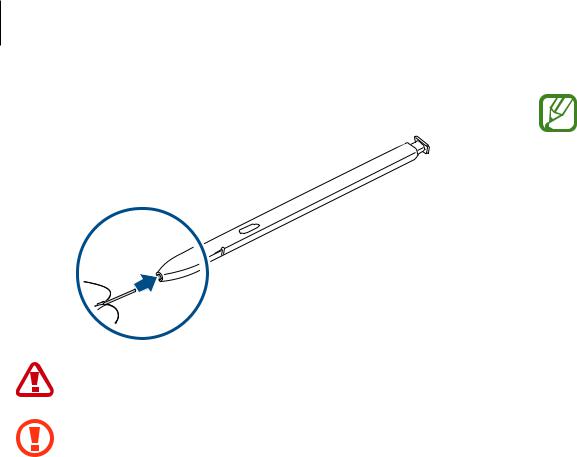
Basics
2 Insert a new nib into the S Pen.
Be careful not to pinch your fingers with the tweezers.
• Do not reuse old nibs. Doing so may cause the S Pen to malfunction.
•Do not press the nib excessively when inserting the nib into the S Pen.
•Do not insert the round end of the nib into the S Pen. Doing so may cause damage to the S Pen or your device.
•Do not bend or apply excessive pressure with the S Pen while using it. The S Pen may be damaged or the nib may be deformed.
•If you use the S Pen at sharp angles on the screen, the device may not recognize the S Pen actions.
•For more information about the S Pen, visit the Samsung website.
•If the S Pen is not working properly, take it to a Samsung Service Center.
22
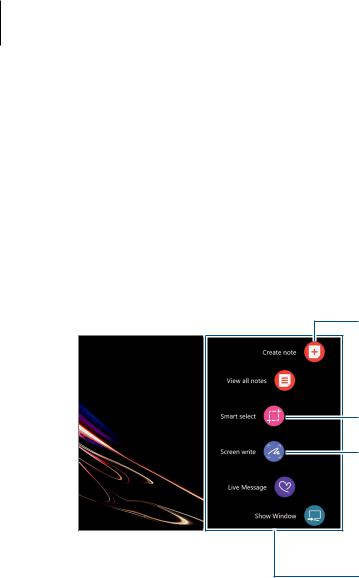
Basics
Air command
Introduction
Air command is a menu that provides S Pen features quickly.
To open the Air command panel, hover the S Pen over the screen and press the S Pen button.
Alternatively, select the Start button ( ) →Air Command.
) →Air Command.
Create note
 View all notes
View all notes
Smart select
Screen write
 Live Message
Live Message
 Show Window
Show Window
Air command
• Create note: Launch the Samsung Notes application and create a new note. Refer to Samsung Notes for more information.
Create note: Launch the Samsung Notes application and create a new note. Refer to Samsung Notes for more information.
• View all notes: Launch the Samsung Notes application and check all saved notes.
View all notes: Launch the Samsung Notes application and check all saved notes.
• Smart select: Use the S Pen to select an area and perform actions, such as sharing or saving. Refer to Smart select for more information.
Smart select: Use the S Pen to select an area and perform actions, such as sharing or saving. Refer to Smart select for more information.
• Screen write: Capture screenshots to write or draw on them or crop an area from the captured image. Also you can capture content that continues across multiple screens at once. Refer to Screen write for more information.
Screen write: Capture screenshots to write or draw on them or crop an area from the captured image. Also you can capture content that continues across multiple screens at once. Refer to Screen write for more information.
• Live Message: Instead of a text message, create a unique message by recording your actions while handwriting or drawing a live message and saving it as an animated file.
Live Message: Instead of a text message, create a unique message by recording your actions while handwriting or drawing a live message and saving it as an animated file.
• Show Window: Select an area on the screen and show it in full screen mode on an external display. Refer to Show Window for more information.
Show Window: Select an area on the screen and show it in full screen mode on an external display. Refer to Show Window for more information.
23
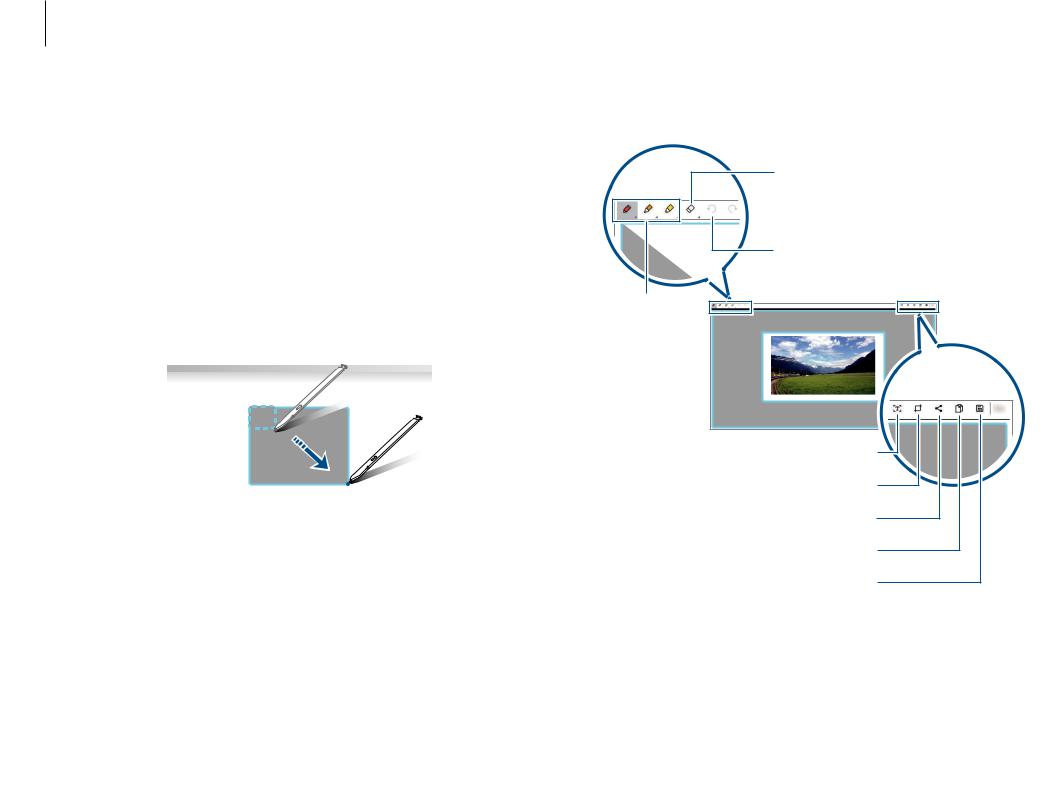
Basics
Smart select
Use the S Pen to select an area and perform actions, such as sharing or saving. You can also select an area from a video and capture it as a GIF animation.
1 |
When there is content you want to capture, open the Air |
||
|
command panel and select Smart select. |
||
2 |
Select a desired shape icon on the toolbar and drag the S Pen |
||
|
across the content you want to select. |
||
|
|
|
|
|
|
|
|
|
|
|
|
3 Select an editing option and edit the selected area.
Eraser mode
 Redo
Redo
Undo
Pen mode
Extract text from the selected area. |
Crop the selected area. |
Share the selected area. |
Copy the selected area. |
Save the selected area. |
24
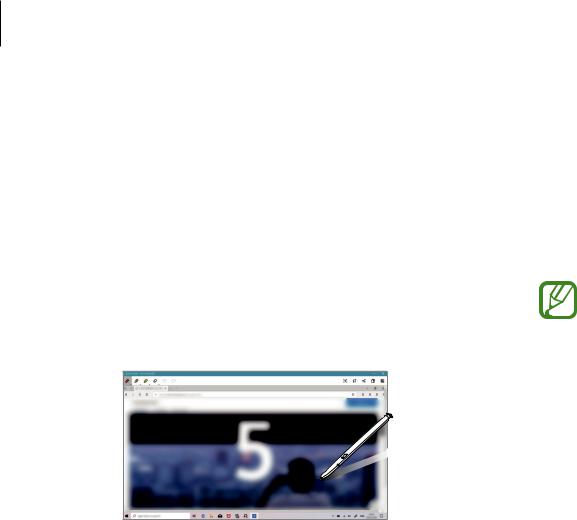
Basics
Screen write
Capture screenshots to write or draw on them or crop an area from the captured image.
1 When there is content you want to capture, open the Air command panel and select Screen write.
The current screen is automatically captured and the editing toolbar appears.
2 Write a memo on the screenshot.
3 Select an option to use with the screenshot.
• : Extract text from the screenshot.
: Extract text from the screenshot.
• : Crop a portion of the screenshot.
: Crop a portion of the screenshot.
• : Share the screenshot.
: Share the screenshot.
• : Copy the screenshot.
: Copy the screenshot.
• : Save the screenshot.
: Save the screenshot.
It is not possible to capture a screenshot while using some application or some features.
Show Window
Show Window allows you to select an area on the screen and show it in full screen mode on an external display. You can draw or highlight items on the screen using the S Pen.
Before using this feature, you must connect the computer to an external display.
Showing a selected area on an external display device
1 |
Connect the computer to an external display device. |
2 |
Open the Air command panel and select Show Window. |
25

Basics
3 Press and hold the Fn key and press the F4 key repeatedly, then select Extend for project mode.
4 Select Start.
A frame for selecting area will appear.
Start is activated only when the project mode is set to
Extend.
5 Drag  to select an area to show in an external display and select Done.
to select an area to show in an external display and select Done.
The selected area will be shown on the external display.
To fix the ratio of the selected area to the ratio of the external display, select  →the Fixed ratio switch to activate it.
→the Fixed ratio switch to activate it.
To stop displaying the screen, select Stop.
Selected
area
Using tools
While showing the screen on the connected display, you can write or draw on the screen using the following tools.
Cursor mode |
|
Pen mode |
Undo/Redo |
Highlighter |
|
|
|
Eraser mode |
|
|
|
||
mode |
|
|
|
|
While using the pen or highlighter, select the desired icon again to change the color or line thickness.
26

Basics
Samsung Notes
Introduction
Create notes by entering text from the keyboard or by writing or drawing on the screen with the S Pen. You can also insert images or voice recordings into your notes.
Creating notes
1 Select the Start button ( ) →Samsung Notes →
) →Samsung Notes → .
.
You can also open the Air command panel and select the
Create note shortcut.
2 Select an input method from the toolbar at the top of the screen and compose a note.
Enter text |
Paint with |
using the |
brushes. |
keyboard. |
|
Write or |
|
draw with |
|
pens. |
|
3 When you are finished composing the note, select Save.
27

Basics
Composing notes in handwriting mode
On the note composer screen, select Pen to write or draw with the S Pen.
Redo |
|
|
|
|
|
|
|
|
|
|
|
|
|
|
Undo |
|
|
|
|
|
|
|
|
|
|
|
|
|
|||
Eraser |
|
|
|
|
|
|
|
|
|
|
|
|
Selection |
||
|
|
|
|
|
|
|
|
|
|
|
|
||||
mode |
|
|
|
|
|
|
|
|
|
|
|
mode |
|||
Pen mode |
|
|
|
|
|
|
|
|
|
|
|
|
Easy |
||
|
|
|
|
|
|
|
|
|
|
|
|
||||
|
|
|
|
|
|
|
|
|
|
|
|
|
|
|
writing pad |
Changing the pen settings
When writing or drawing on the screen, tap |
to change the pen |
type, line thickness, or pen color. |
|
Select the pen  type.
type.
Select the pen  color.
color.
 Select the line thickness.
Select the line thickness.
 Select a new color using the color picker.
Select a new color using the color picker.
Using the line eraser
When you want to erase handwriting from a note, tap  and select an area to erase. Alternatively, select an area while pressing and holding the S Pen button.
and select an area to erase. Alternatively, select an area while pressing and holding the S Pen button.
To change the eraser type, tap  once more.
once more.
•Erase line by line: Erase the line you select.
•Erase touched area: Erase only the area you select. You can adjust the size of the eraser by dragging the size adjustment bar.
•Erase all: Clear the note.
Even with a smaller eraser, you may still not be able to precisely erase the intended part.
28

Basics |
|
|
|
|
|
Editing handwritten notes |
|
|
3 Edit the input using the available options. |
||
Edit handwritten notes using various editing options, such as |
• |
Cut: Cut out the input. To paste it to another location, |
|||
cutting, moving, resizing, or transforming. |
|
|
|
select and hold the location, and then select Paste. |
|
1 If a note contains handwriting, select |
. |
|
• |
Copy: Copy the input. To paste it to another location, select |
|
once more. |
|
and hold the location, and then select Paste. |
|||
To change the shape of the selection, select |
• |
Delete: Delete the input. |
|||
|
|
|
|||
2 Select the input or draw a line around the input to select it. |
• |
To front: Send the input to the front. |
|||
• |
To back: Send the input to the back. |
||||
To move the input to another location, select the input, and |
|||||
|
|
||||
then drag it to a new location.
To change the size of the selection, select the input and drag a corner of the frame that appears.
29
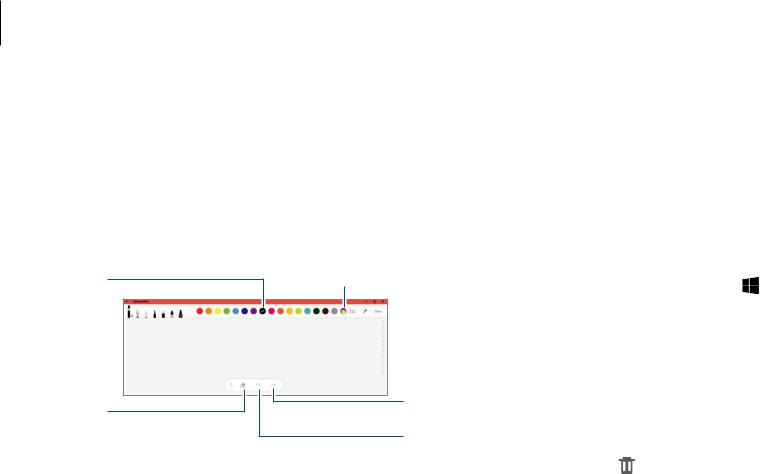
Basics
Painting with brushes
On the note composer screen, select Brush to paint with various brushes.
When you are finished, select Done to insert your painting into the note.
Change the brush color.
Brush  settings
settings
Eraser
mode
Select a new color using the color picker.
 Insert the painting into the note.
Insert the painting into the note.
Redo
Undo
Inserting images into a note
On the note composer screen, select  →Image and select the image you want. The image will be inserted into your note.
→Image and select the image you want. The image will be inserted into your note.
Inserting voice recordings into a note
On the note composer screen, tap  →Voice recordings to make a voice recording. Tap
→Voice recordings to make a voice recording. Tap  to stop recording. The voice recording will be inserted into your note.
to stop recording. The voice recording will be inserted into your note.
Deleting notes
1 |
Select the Start button ( ) →Samsung Notes. |
|
You can also open the Air command panel and select the |
|
View all notes shortcut. |
2 |
Right-click the note you want to delete on the note list. |
|
To delete multiple notes, tick the notes you wish to delete. |
3 |
Select . |
30
